#baudrilliard
Explore tagged Tumblr posts
Text
for the past like 3 years I've genuinely been considering finishing and posting the midwestern suburb miku thing on ao3....and like....damn should i....
#hatsune miku#writing#i don't even know if it counts as a ff because it's technically completely removed from it's original meaning???#its like the 2nd stage simulacrum of hatsune miku#or whatever tf baudrilliard said#i don't remember the categories anymore#ao3
4 notes
·
View notes
Text
He stopped liking my insta stories because i told him i don't understand Baudrilliard's writing
6 notes
·
View notes
Text
Analytical Application 3: Poststructuralism and Postmodernism
Postmodern: The Intro Scenes

Tykwer, 1998, 0:01:40 - 0:02:53

Tykwer, 1998, 0:04:38 - 0:04:45
Postmodernism is a reaction against modernism or what is, through mass, popular, or high culture, considered the establishment and therefore even the enemy[1]. Postmodernism is hard to define as it is defined by what it is reacting against and has multiple versions. To expand on the last part, postmodernism experiences a phenomenon where with an emergence of postmodernism comes the changing of the tide of what is considered establishment and hence a change in reaction against that establishment and the formation of a new postmodern. The old postmodern becomes the modern and a new postmodern (which may even resemble the old modern in a rebellious act of nostalgia) is formed. To be succinct, postmodernism is a challenge to what we consider good and true.
We as audience members have come to expect a certain significance from the opening scenes of a film. Something that clues us in on our main characters and main conflict. The opening scene of Run Lola Run is a challenge to this structure, and a larger challenge to the idea of truth and importance. It is postmodern in style as it challenges cinematic manners like a kid refusing to give a proper introduction. We do not see our main characters, save for there brief photo introduction in the opening credits of all the cast. We do see our side characters, who with a traditional analysis lenses do not have that much impact on the plot. For example, Lola merely bumps into the first lady with the baby while running. This lady through traditional narrative lenses can be summarized to merely an obstacle, yet it is she along with several others who the camera focuses on in the frenetic crowd of people. This opening scene, paired with the subsequent scene zooming in to Lola from the birds eye view of Berlin diminishes the importance or singularity of the main character and thus challenges the modern film notion of main character and the modern ideology of singularity. How can we view Lola the same as any main character when we know her place in the world is so small and rubbed against so many other people with potential stories of their own?
This opening scene is not only postmodern in style but postmodern in ideology challenging the things we collectively tell ourselves (that there is truth, reason, and destiny) in order to quell the overwhelming mystery of human nature. The narration at the beginning of the film, a subversion of narration that usually gives us insight to the main character or plot, asks us to question everything and accept the futility of answers. “Why do we believe anything at all?” (2:12) Cheekily our narrator, a referee, says that the only thing one can be sure of is that “the ball is round. The game lasts 90 minutes… Everything else is pure theory” (2:40). The only thing in life we can be sure of is its game like quality. It lasts a certain amount and yet it is always rolling. The other rules (modern structures and beliefs) we impose on the game (on life) are merely theory.
Postmodernism is the challenge of the norm, and the opening scene of Run Lola Run challenges what we have come to expect from opening narration scenes as well as prods us to challenge certain ideologies about structure and truth.
[1]Fredric Jameson, “Postmodernism and Consumer Society”, in Modernism/Postmodernism, ed. E. Ann Kaplan (New York: Routledge, 2014), 164, 165.
Hyperreality: the “And Then” Montages

Tykwer, 1998, 19:11-0:19:17
Baudrilliard uses hyperreality to describe what we think is real in a world that is not real. His example of Disneyworld discusses how Disney attempts to paint itself as imaginary to enforce that the world outside of Disney is real. Hyperreality is this “real” world; “deprived of symbolic substance, it doubles back upon itself, draws its energy from its own reflection and its disappointment with itself”[1]. Disneyland mimics the “real world” and thus gives it a certain legitimacy that it is only able to gain through its reflection. Hyperreal is the resemblance/construction of a sense of realness that is created through the manipulation of the ever increasingly indistinguishable perceived imaginary and real. Disney crafts a hyperreality for the outside world, while also providing an immersive enough capitalistic experience that it becomes its own form of hyperreality (a “third-order simulation”)[2].
During each of Lola’s runs, the side characters she bumps into interrupt the narrative with quick flash montages of images showing their supposed fates. In a sense, these montages are confirming the reality of Lola’s situation while paradoxically making the audience question the reality principle’s tenets of destiny and fate.
By imposing this fullness of life on these characters that Lola only briefly interacts with, the projected lives of others create an illusion of reality about us and the wider world. A hyperreality is created because our own experiences are supposedly mirrored in that of others even if we aren’t privy to these experiences. If the other people we interact with all have full lives and fates awaiting them, then we ourselves do and there is a larger order to the world which we belong to.
There is, however, no certainty to the fates of the characters in the montages. It is uncertain the first time around if this is projected or if there is any truth to it. Additionally, through the subsequent runs, these montages change. This goes with the narrative idea of how different choices have different outcomes, but it also calls to question the idea of truth or destiny. If all these side characters can have such different fates, how can there be any truth to what one is supposed to experience. And if all these side people in life’s fates are uncertain, so is the supposed humanity and realness we have imposed on ourselves or on Lola. The hyperreal is exposed as a falsification of real drawn from simulation: there is no reality or truth in these projected futures of others and thus we are drawn to question the source which the hyperreal mirrors.
Through the several and then montages, a hyperreality about the fullness and realness of the world Lola presides in is created and then questioned through subsequent alternate montages that questions the solidity of fate in others and in oneself.
[1]Jean Baudrillard, “from ‘Simulacra and Simulations”, in Modernism/Postmodernism, ed. and with Introduction by Mark Poster (New York: Routledge, 2014), 161.
[2] Baudrillard, 154.
Pastiche: the Animated Running Sequences


Tyler, 1998, 0:02:53 - 0:04:01, 0:55:00 - 0:55:22
Pastiche, although like parody, is an imitation of something that lacks the intent to ridicule or criticize what it is replicating. Many a times, parody is criticizing because one has the notion that what it is discussing does not measure up to reality or derails from reality in a laughable or even punishable way. Pastiche does not carry this notion and is in a sense an empty parody.[1] It accepts what it is copying as either the truth that parody would compare it to does not exist (like in Baudrillard’s theory) or has become invalid (such as when postmodern becomes the new modern).
The first time we see Lola is in animated form during the credits. In these credits she is running forward and dodging many elements including a clock counting down time. This is reminiscent of many early video game platformers where the objective is merely to go forward (run) and avoid obstacles in a timely manner (a time challenge). In each of the animated sequences when Lola runs out of her home, there is the neighbor with the dog who provides an early obstacle (like the goombas in Mario). In the third run, Lola expertly leaps over the dog a la the world’s favorite mustached overall wearing plumber. Additionally, I want to point out the similarity between Lola’s character design and that of Lara Croft. They both have blue-ish tank tops and cargo like bottoms with a belt. The techno music playing in the background confirms that these choices and imitations are done consciously.
The style of videogames is imitated in the movie, but this means that it must be determined if the movie is doing pastiche or parody. The movie never mocks the genre of video games or suggests that what happens in the animated sequences is unimportant to the story. For example, in the second one she trips over the dog guy’s leg in the animation and we see her limp after she fell at the bottom of the stairs in the physical film world (0:35:19 - 0:35:41). To be a parody of video games, the movie would have to suggest the video game world or a character’s habit of viewing the world in a video game style is a laughable derailment of reality. This film, however, uses the video game style to reveal something about reality rather than comment on video games dissimilarity or failure of reality. Videogames are like Baudrillard’s Disneyland: a way to reflect the real in a way that justifies its realness and saves the reality principle. Run Lola Run suggests that life and the arbitrary choices we all make are like a video game. There are desirable outcomes in this world, but there is no truth. Who’s to say whether Lola died or succeeded? Who’s to say which is the truth? Aren’t they all as equally likely? A parody of video games would stick to enforcing the reality principle, while this pastiche of video games breaks down the reality principle.
This pastiche of the video game style in the film doesn't parody the style in comparison to reality but rather breaks down the hyperreality we have created between game and life, thus revealing the true game like nature of life.
[1] Jameson, “Postmodernism and Consumer Society”, 167.
Parody: the Casino Scene

Tykwer, 1998, 1:05:10 - 1:08:37
Parody, as stated before in my definition of pastiche, is imitation that through its imitation highlights the discrepancy of the thing being imitated from the real or what should be real. Parody has a satirical impulse, and a latent belief in a possibility of discovering the real by imitating and thus mocking the false[1].
The serious and stoic nature of the others in the casino feels misplaced and odd within the world of Run Lola Run. Despite Lola being the outcast (by her hair and her standing while everyone else is sitting), we the audience have spent enough time with her to feel that the oddness belongs to everyone else. The music also decreases its frenetic techno nature and becomes more in line with a traditional drama score. The way that the other characters hold themselves, the more dramatic pauses in place of fast paced shot editing feel like they are from a different movie. The table is shown from a bird’s eye view with several close ups allowing the audience to see the bets being made and the chips being given out. The last roulette round uses a slow motion shot to reveal Lola’s win. It’s tense, mesmerizing, and a lot slower than most of the very fast movie. For the most part the scene is way more serious until Lola wins her second round by emitting a piercing scream that breaks glasses, catches everyone’s attention, and causes the ball to land on her number.
This provides a first level of parody, where Lola’s scream is a subversion of what is expected and thus makes us believe in the real- where these tense scenes should be won sheerly by luck or perhaps by some cheating. This is, however, reveals another level of parody, or perhaps more accurately reveals the similarity between Lola’s ridiculous scream winning her fortune and the usual results of gambling scenes. The parody and the real are indistinguishable. Lola’s scream is a ridiculous move of willpower forcing the hand of luck, which is exactly what everyone else in the casino is trying to do (especially the cheaters). They may hide their desperation to the arbitrary nature of fate better than the disheveled Lola, but they too are playing the game and sometimes being played by the game. The expected outcome of this gambling scene due to its imitation of other movie gambling scenes is subverted in a parody that compares Lola’s fantastical win to reality and realizes the similarity of the two, thus discarding the idea of what real is and replacing it with the truth being the game and everything else being theory.
Parody is a more viscous intent of imitating, that can sometimes become indistinguishable from a perceived truth and thus shedding a light on one’s inability to determine truth[2]. The casino scene in Run Lola Run is a parody of the tense and serious nature of casinos in film and in theory. Her win through a ridiculous and supposedly unreal force causes one to look at what is perceived as the real way to win at casinos which ultimately, because casinos are the ultimate game of chance, causes one to see the game nature of the world with its arbitrary nature and consequences.
[1] Jameson, 167.
[2] Baudrillard, 156.
Nostalgia Mode: the Second Conversation in Red


(left) Tykwer, 1998, 0:52:29 - 0:54:23
(right) Blizzard Entertainment, 2012, Diablo 3
Nostalgia mode, different from the nostalgia film, is something that gratifies a deep need/desire to return to something before, perhaps an older time through reliving its aesthetic rituals[1]. Jameson’s idea of the nostalgia mode focuses on movies that either relive the past with factual detail or recall some kind of past longing or experience even if it itself did not exist in historical reality like Star Wars[2].
The movie, during its cut scenes tinted red after the death of either Manni or Lola, cast a nostalgic light on the events that have already happen and created a strong desire to go back and get it right. The second and third runs are a nostalgia mode for the first run. The cut scenes do more than just separate the runs but provide motivator for the next. Specifically, the second cut scene, after Manni has died, provides Lola a strong motivation to prove her love (and her unwillingness to let him die) through her third and final run. As stated before, this is very reminiscent of a video game death screen and in certain games cut scenes that then motivate the player to not get it wrong. During these chats, which are a slow moment unscored by the frenetic pulses of the runs, the characters question choice and fate. If he died, was it always her fate to be with someone else? Who is to say that there is even a fate that put them together in the first place? These questions, placed right after a death of a character, create this deep longing for a controlled world or at least one where, if only for a moment, one can hold the reins of chance.
Nostalgia mode is the use of aesthetic replication to gratify a need to go back and reexperience a time or feeling. The post death scene chats create this desire in Lola (and in an audience that is rooting for her) to go back and relive the circumstances leading up to this point in a different matter. The subsequent runs which are similar enough to the first satisfy this need to go back. In consistency with its similarity to the video game world, Run Lola Run also satisfies the desire to immerse oneself in the simpleness of video games where the arbitrary nature of the world is kept at bay through multiple chances at getting the best outcome.
[1] Jameson, 170.
[2] Jameson, 169.
1 note
·
View note
Photo
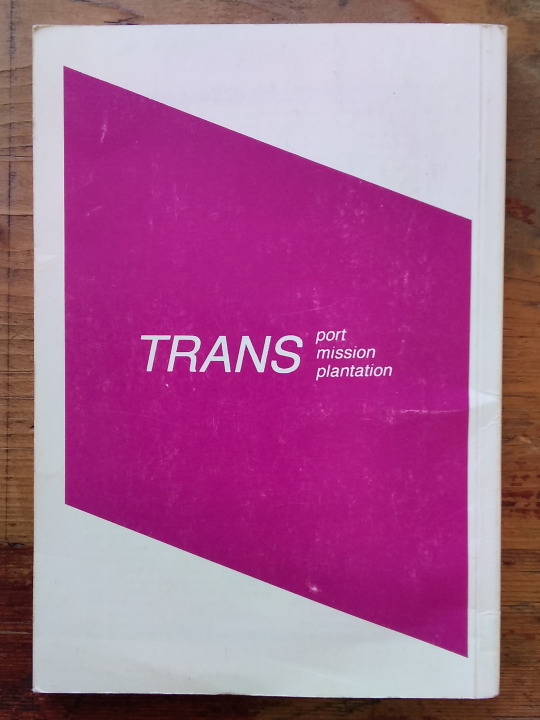
*
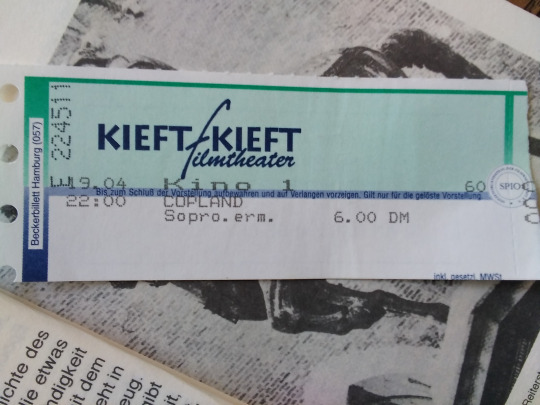
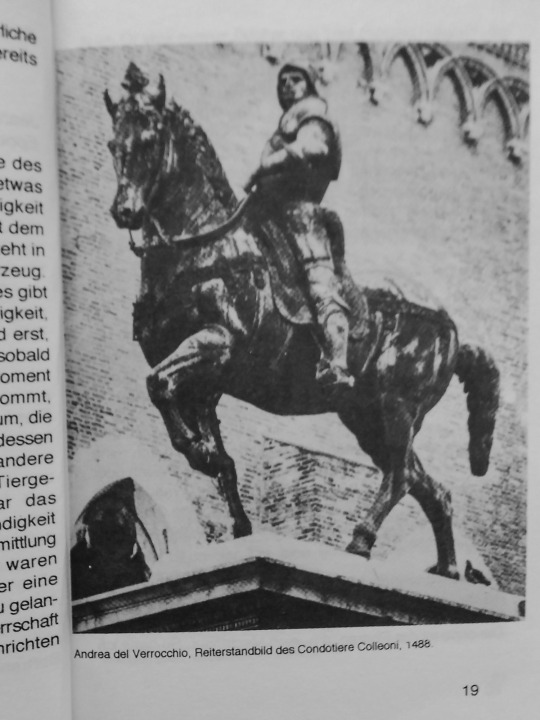
*

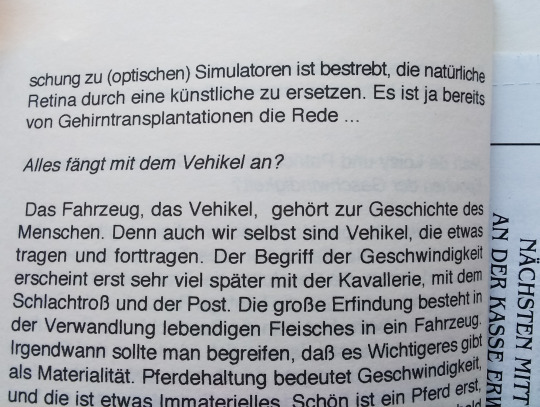
*

#paul virilio#revolutionen der geschwindigkeit#merve verlag#berlin#1993#baudrilliard#coolkiller#aufstand der zeichen#bookmarks#copland#peripheries#chemnitz#2007#about photography#digital photography
1 note
·
View note
Quote
Virtual Reality in itself is a rather miserable idea: that of imitating reality, of reproducing its experience in an artificial medium. The reality of the Virtual, on the other hand, stands for the reality of the Virtual as such, for its real effects and consequences (Žižek 2004:3)
“Contradictions of Hyperreality: Baudrillard, Žižek, and Virtual Dialectics” by Ted Stolze, Cerritos College, Norwalk, CA.
International Journal of Zizek Studies. Volume Ten, Number One.
ISSN 1751-8229
https://zizekstudies.org/index.php/IJZS/article/download/92/373
0 notes
Quote
Our images are like icons: they allow us to go on believing in art while eluding the question of its existence. So perhaps we out to treat all present-day art as a set of rituals, and for ritual use only; perhaps we ought to consider art solely from an anthropological standpoint, without reference to any aesthetic judgment whatsoever.
Jean Baudrillard, The Transparency of Evil: Essays on Extreme Phenomena. (p. 19 in ISBN 978-1-84467-345-2)
#quotes#Jean Baudrilliard#2009#French thought#philosophy#aesthetics#critical theory#ritual#art#anthropology#images#icons#belief
1 note
·
View note
Text
i mean even the fact the first thing i heard about them was how they look like industry plants feels crazymaking to me like the industry planters know that making them appear like indsutry plants will give them negative press which will make people listen to them anyway
not to add fuel to the any press is good press complex but tramp stamps feels like a psyop girl band based on everydayfeminism/buzzfeed dot com brand feminism 5 years late. also it sounds like dorian electra so if its actually all produced by some pc music sick fuck then i wouldnt be surprised
4 notes
·
View notes
Text
I’ve discussed this before but it’s so upsetting studying about the 80s in Greece when that decade and all the policies and social structures it brought is at least half the reason why this country is as fucked up as it is now
5 notes
·
View notes
Text
my favorite thing about the Wikipedia article for Kayfabe, the concept of suspended disbelief in wrestling, is that the see also section has its first listed article Jean Baudrilliard’s Simulation and Simulacra
3 notes
·
View notes
Text
“Machines produce only machines. This is increasingly true as the virtual technologies are becoming more perfect. At a certain level of machine-ness, of immersion in virtual machinery, there is no more distinction between man and machine. The machine is on both sides of the interface. You may indeed be merely the space of the machine now: man has become the virtual reality of the machine, its mirror operator. This has to do with the very essence of the screen. One cannot look “through” the screen as if it were a looking-glass. The dimensions of time itself merge there in “real time.” The characteristic of any virtual surface is first of all to be there, empty and thus likely to be filled with anything. It is left to you to interact in real time with the vacuum.”
-”Violence of the Virtual and Integral Reality” by Jean Baudrillard
“There are so many ghosts in our machines—their locations so hidden, their methods so ingenious, their motives so inscrutable—that not to feel haunted is not to be awake.”
-”If You’re Not Paranoid, You’re Crazy” by Walter Kirn, The Atlantic, Dec. 2015
23 notes
·
View notes
Text
"Hay dos formas de olvido: o bien la exterminación lenta y violenta de la memoria, o bien la promoción espectacular, el paso del espacio histórico al espacio publicitario. (Baudrilliard: 1993 : 41)".
"Hecho en Chile". Reflexiones sobre el patrimonio cultural. Vol. II. 2021. P. 309.
0 notes
Text
don't actually read baudrillard though watch some YouTube videos about it or something, baudrilliard couldn't use words like a normal people
4 notes
·
View notes
Text
CHAPTER 2 SOCIOLOGICAL PERSPECTIVE: THE SELF as a PRODUCT of SOCIETY

“Does society affect how a person acts?” this is one of my questions upon discussion of the self. Before, I thought that the self is being developed only by the person but I proved it wrong.
In this chapter I recognized how sociology affects people’s behavior. In my thoughts, people nowadays are greatly influenced by their surroundings especially the media. Through the easy access of the internet people tend to see and be able to patronize other’s culture. However, in this current accessibility the attainment of the self is freely chosen no one would dictate what you will do. In the theory of George Herbert Mead of the social self is based on the viewpoint that the self arises from social experiences, such as witnessing and communicating with others, listening to the opinions of others about themselves, and internalizing outward perceptions and inner feelings about oneself.

According to Gery Lanuza post modern society individuals tend to have more free will in choosing their authentic core since they are no longer restricted by customs and tradition. For me this is really true because of the easy access of internet people most likely would disregard cultural customs and tradition and this relates to the idea of Jean Baudrilliard that that mass media and cultural practices of advertising greatly influence the behavior of a person.
0 notes
Text
Nothing is Original (and thats ok) - Personal Response/Reflection
Postmodernism and appropriation art go together hand in hand. Formed from the coming of Neo Dada and Pop art, postmodernism, the reaction against ideas and values of modernism. A term associated with ‘scepticism, irony and philosophical critiques’. Took the concept of originality then turned it upside down. By rejecting modernism and using forward thinking, postmodernism questioned the ‘master narrative’. The dada readymade influencing postmodernism to further question the originality of the work with appropriation art paving the way even to the extent of barely altering, if at all, a photograph then using it as your own.
This relationship was a focus of many theories such as Barthes, Foucault and Baudrillard. Jean Baudrilliard focusing on ‘the simulacrum’ which essentially is an image or representation of someone or something that is not true, fake, a fable. This concept of a representation of someone not being real can be seen in the more recent work of an infamous appropriation artist, Richard Prince. Prince draws from subcultures and cultural cliches to show how we accept the stereotypes and messages from marketing that are shown to us on social platforms such as Instagram. He takes the objects from their original environment then places them in a gallery for example which makes the familiar becomes unfamiliar and uncomfortable, inviting his viewers to criticise him and his subject matter. An example of his work, is a series in which he appropriates peoples Instagram posts by taking a screenshot but changing the caption then hanging them on a gallery wall. This work has caused a lot of uproar with peoples Instagrams who have been repurposed as they were not ask if their image could be used. People such as Melania Trump have filed lawsuits and won due to the originality and ownership of Prince’s work.
At first I thought his work to be a blatant copy of someone else's photo however upon looking further into theories around postmodernism and appropriation it is clear to me that his work is a protest of how we use social media as a marketing tool, with us the viewer accepting what we see on our screens to be real. On one hand, I can understand the anger of their photographs being used however it raises questions around ownership. For example if they have put their photograph out their on social media and the internet, possibly without a copyright, whose image is it?

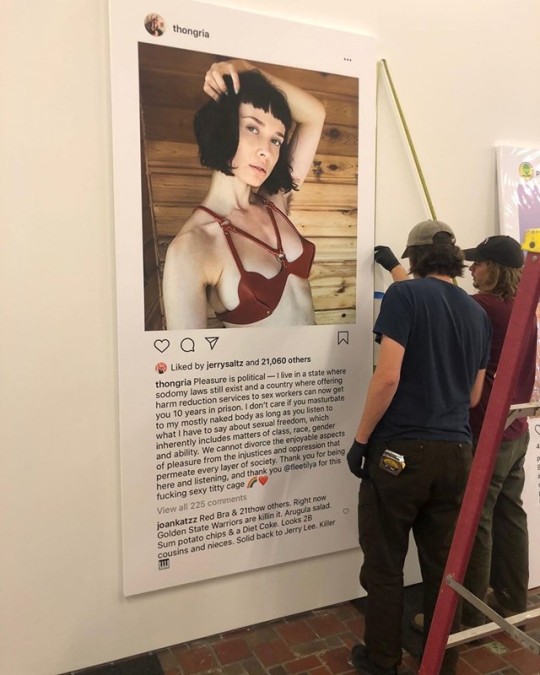
links:
https://www.anothermag.com/art-photography/9602/the-new-exhibition-examining-appropriation-in-art
https://www.theguardian.com/technology/2015/jul/18/instagram-artist-richard-prince-selfies
https://www.dazeddigital.com/art-photography/article/46679/1/richard-prince-causes-controversy-instagram-appropriation-art-artwork-theft
https://www.nytimes.com/2017/07/20/arts/design/richard-prince-instagram-copyright-lawsuit.html
https://www.theartstory.org/artist/prince-richard/
https://www.theartstory.org/definition/postmodernism/
https://www.tate.org.uk/art/art-terms/a/appropriation#
0 notes
Photo


Jean Baudrilliard fashion, or the enchanting spectacle of the code.
Figure 1: Tondo, M. (2016) Victor&ROLF 2016 Couture, Available at: https://www.vogue.com/fashion-shows/fall-2016-couture/viktor-rolf/slideshow/collection#1
Figure 2: Vlamos, Y. (2016) Dries Van Noten Fall 2016 Menswear, Available at: https://www.vogue.com/article/dries-van-noten-gender-free-clothingAccording to Baudrillard (2007,p.463) ’The aesthetic of renewal: fashion draws triviality from the death and modernity of the deja vu.’
The Victor and Rolf Autumn 2016 Couture collection illustrates this argument because, they transformed their old collections into dramatic new clothes. The up cycling was a play with proportions of everyday base layers handwoven with leftover fabrics, boosted with swirling tulle volumes and embellished with plenty of hardware and buttons.
Vogue said about the collection: “Haute couture is inherently a push-and-pull of old and new: old techniques, new materials; old maison, new designer; old silhouettes, new interpretations.”
This links back to the Jean Baudrillard’s point that fashion designers take from the past and is a prime example of his theory that beyond the death of a form, there’s ‘always a chance of a second existence’ (p.463)
In figure 2, the image shows a clear example of gender bending in fashion by Dries van Noten.
Brings to the conclusion following the view of Baudrillard.J (2007,p.471) ‘fashion has only to do with the feminine and not with women. Society in its entirety in becoming feminine to the extent that discrimination against women is coming to an end.’ evident that men’s fashion is becoming more feminine with generations. People are less judgemental of boys dressing in feminine clothes. The line of things being too girly is fading rapidly.
Baudrillard,J. (2007) ‘Fashion , or the enchanting spectacle of the code’ in Bernard,M. (2007) Fashion theory. A Reader New York: Routledge pp.463-474
1 note
·
View note
Text
so in order to get through my media psychology class i made saucy commentary in between real class notes and as i am now creating my final study guide and going back through all my notes i thought i might share some gems
welcoem to my twisted mind (tag yourself tbh)
“the example she gave was ‘teeth' i want to fucking die”
“critical think up in this bitch”
“oh my god ya girl needs almonds”
“i really don’t want to get called on as the only american in the room to explain manifest destiny”
“hi thanks for checking in freud is still a piece of garbage”
“tag yourself i’m really this girl in the row in front of me who has been looping a shiba inu gif for five minutes”
“can i make this gay and marxist? yes, probably”
“miss me with this heternormativity pls friendo”
“this bitch really playing solitaire next to me”
“you know, personally, i would not call ‘silence of the lambs’ feminist filmmaking but to each their own i guess?????????”
“y this college boy have on dad shoes i can’t do this”
“knock knock, it’s youtube”
“baudrilliard is jerking off right now ugh”
“if the corpse bride half decomposed y she got ghost titties”
“can we stop celebrating white men for being edgy please”
“call me yr nihilist princess”
“the gay shoe clerk? mmmmmmmEEEEEEEEE???”
34 notes
·
View notes